
A customized pull-up bar ab workout routine might help you attain shredded abs. The pull-up bar is an adaptable and fundamental part of many abdominal workouts. Despite the plethora available, the ones we highlight here provide effective muscle engagement to target all your abdominal muscles.
At the same time, they can help you lose weight. You’ll accomplish all of this while improving your general upper-body strength. Achieve your abs goals faster by incorporating these exercises with fat burner supplements.
Best Pull Ups For Abs
Do pull ups work abs? Here are the best pull-up bar ab exercises to add to your routine:
Best Effective Pull Up Bar Ab Workout
These eight pull-up bar workouts can get you there if you have not imagined yourself with a toned core yet.
Hanging Leg Raises
This pull-up bar exercise primarily targets the rectus abdominis, known as the six-pack muscles. It also engages the hip flexors and lower abs.
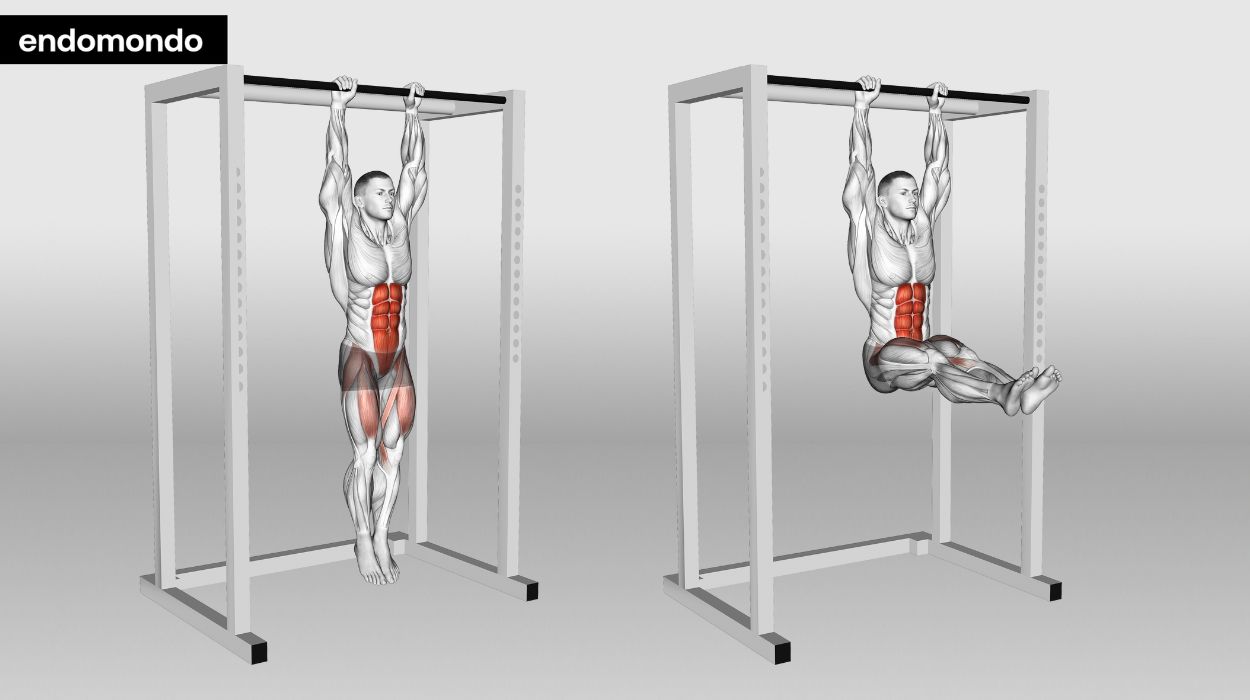
How to do:
- Hang with hands shoulder width from the pull-up bar with an overhand grip, straight leg raise, and feet together.
- Keeping your leg muscles extended, engage your core and slowly raise your legs until they are parallel to the ground.
- Pause briefly at the top, then lower your legs with control.
- Inhale as you raise your legs, exhale as you lower.
Tips:
- Initiate the lift by engaging your lower abs and lifting your legs while keeping them straight.
- Control the movement, avoiding any swinging, to maximize the effectiveness of the exercise.
- Keep your upper body steady by maintaining a firm grip on the bar.
Optimal Sets and Reps: 3 sets of 10-12 repetitions.
Hanging Knee Raises
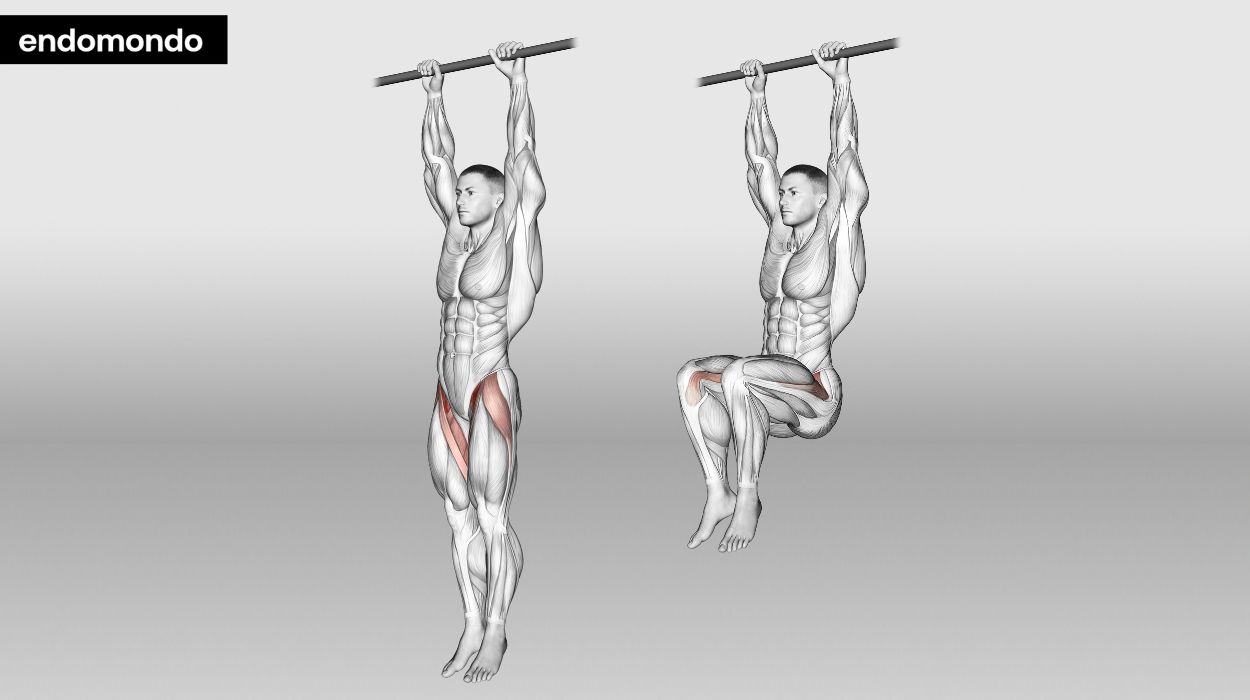
This hanging knee tuck primarily targets the lower abs while engaging the hip flexors and core muscles.
How to do:
- The proper starting position is hanging from the pull-up bar with an overhand grip, legs straight, and feet side by side.
- Bend your knees and raise them toward your chest while engaging your core.
- Pause briefly at the top, then lower your knees with control.
- Inhale as you raise your knees, exhale as you lower.
Tips:
- Initiate the movement by engaging your core and lifting your knees toward your chest.
- Avoid using momentum; focus on controlled, deliberate movements for maximum effectiveness.
- Keep your upper body steady by maintaining a stable grip on the bar.
Optimal Sets and Reps: 3 sets of 12-15 repetitions.
Hanging Toes To Bar
The hanging toes-to-bar belly exercise is one of many advanced hanging ab exercises. It targets the entire core, including the rectus abdominis, obliques, and hip flexors.
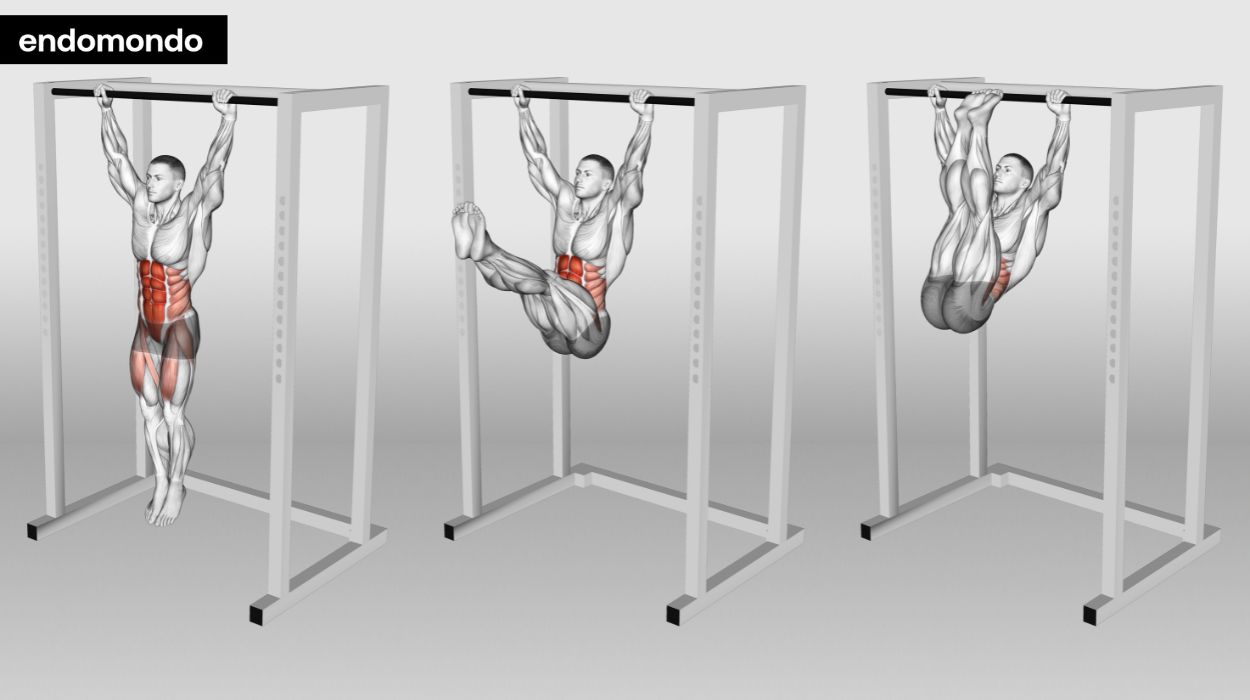
How to do:
- Start by hanging from the pull-up bar with an overhand grip, legs straight, and feet together.
- Initiate the movement with the goal that your toes touch the bar by engaging your core and lifting your legs.
- Control the descent as you lower your legs
- Exhale as you bring your toes to the bar, inhale as you lower.
Tips:
- Initiate the movement from your core, lifting your legs while keeping them straight and your toes pointed.
- Control the motion to avoid swinging, focusing on a slow and controlled raise.
- Maintain a strong grip on the bar and engage your upper body for stability.
Optimal Sets and Reps: 3 sets of 8-10 repetitions.
L-Sit Hang
The L-sit hang primarily targets the lower abs while also engaging the hip flexors and core.
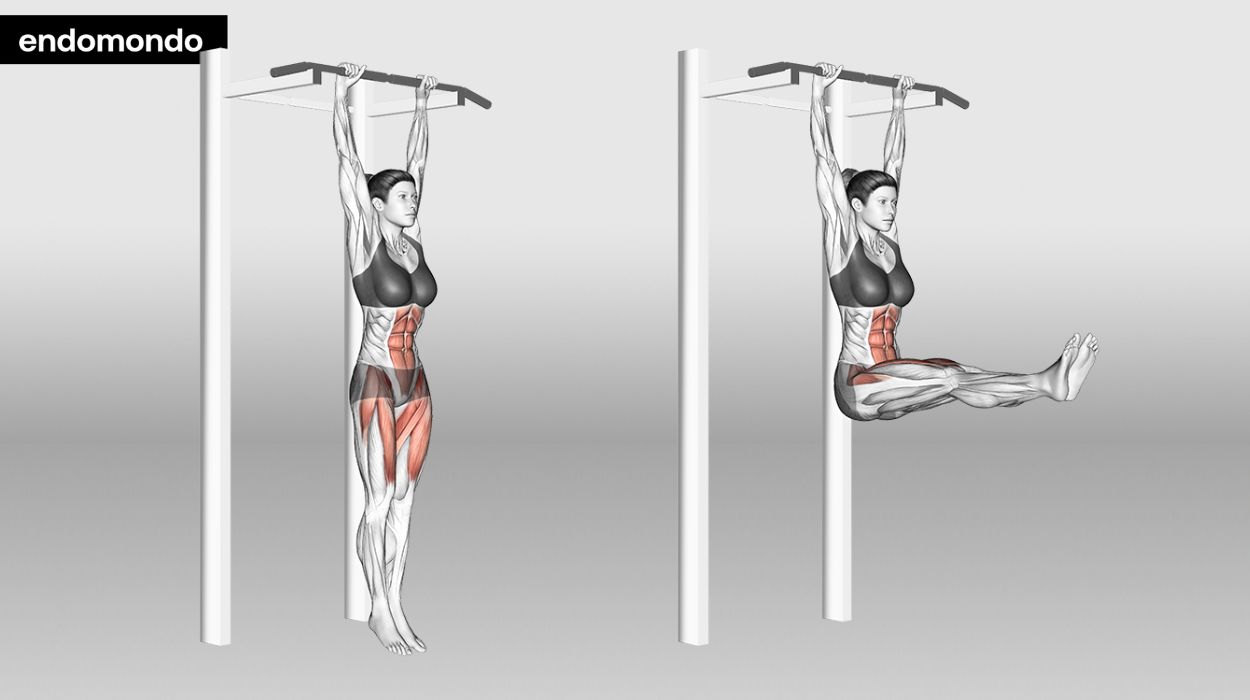
How to do:
- Suspend from the pull-up bar with an overhand grip, legs extended straight in front of you.
- Engage your core and lift your legs until they are parallel to the ground, forming an L-shape.
- Maintain this position for as long as possible, keeping your core tight and shoulder blades down.
- Breathe normally and hold the position for 15-20 seconds.
- Return to starting position.
Tips:
- Keep your legs straight and engage your core to lift them parallel to the ground.
- Maintain a strong grip on the bars or rings and push your shoulders down away from your ears.
- Start with shorter holds and progressively increase the duration as your strength improves.
Optimal Sets and Reps: 4 sets of 15-20 seconds.
Hanging Knee Raise Twist
This ab pull-up bar exercise targets the entire core, including the rectus abdominis, obliques, and hip flexors.
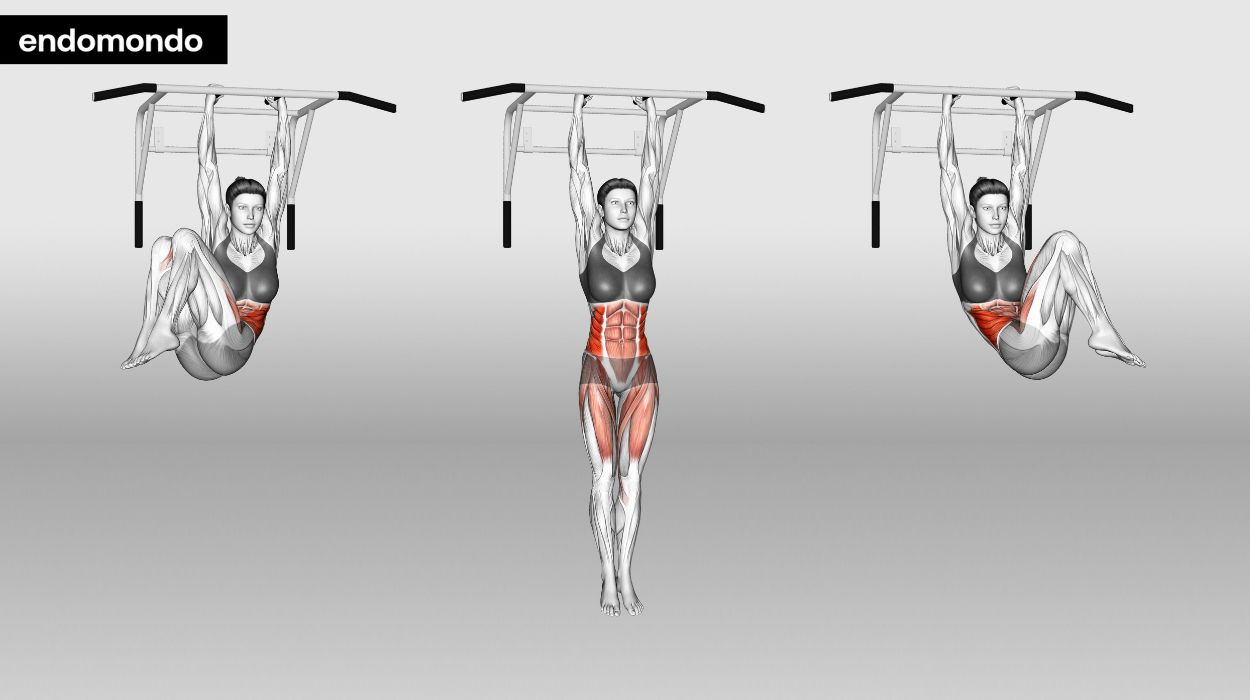
How to do:
- Start hanging from the pull-up bar with an overhand grip, legs straight, and feet touching.
- Initiate the movement by bending your knees and raising your legs forward toward your chest.
- At the top of the movement, twist your hips to one side, engaging the obliques.
- Return to the starting position, then turn to the other side.
- Exhale as you twist your knees, and inhale as you return to the center.
Tips:
- Engage your obliques by twisting your knees to the opposite side of your body during the raise.
- Control the motion to avoid swinging; focus on a slow and deliberate movement.
- Maintain a stable grip on the bar and keep your upper body still throughout the exercise.
Optimal Sets and Reps: 3 sets of 10-12 repetitions.
Upside-Down Hanging Crunches
Also known as inverted hanging crunches, these are advanced ab exercise that challenges the core and target the lower abs.
How to do:
- Start by hanging upside down from a pull-up bar with your knee joints over the bar.
- Engage your core and bring your torso up, aiming to touch your hands to the bar above you.
- Maintain control as you slowly lower your legs back down.
- Exhale as you crunch your knees toward your chest, inhale as you extend.
Tips:
- Maintain control to prevent swinging, focusing on a slow and controlled crunch motion.
- Focus on squeezing your abdominal muscles at the top of the movement to maximize the contraction.
- Keep your back straight and avoid excessive swinging or arching to maintain proper form.
Optimal Sets and Reps: 3 sets of 10-12 repetitions.
Hanging Scissors
The Hanging Scissors routine targets the entire core, including the rectus abdominis, obliques, and hip flexors.
How to do:
- Suspend from the pull-up bar with an overhand grip, straight legs and feet together.
- Start the movement by crossing one leg over the other, then opening your legs wide in a scissor-like motion upwards.
- Continue alternating the crossing pattern while maintaining control and engaging your core.
- Inhale as you cross your legs, exhale as you switch.
Tips:
- Maintain control as you scissor your legs, engaging your core muscles throughout the movement.
- Avoid swinging or using momentum; focus on a controlled, deliberate motion.
- Keep your upper body steady with a firm grip on the bar, and breathe steadily.
Optimal Sets and Reps: Three sets of 10-12 repetitions per side.
Hanging Windshield Wipers
The Windshield Wipers routine targets the obliques and core ab muscles.
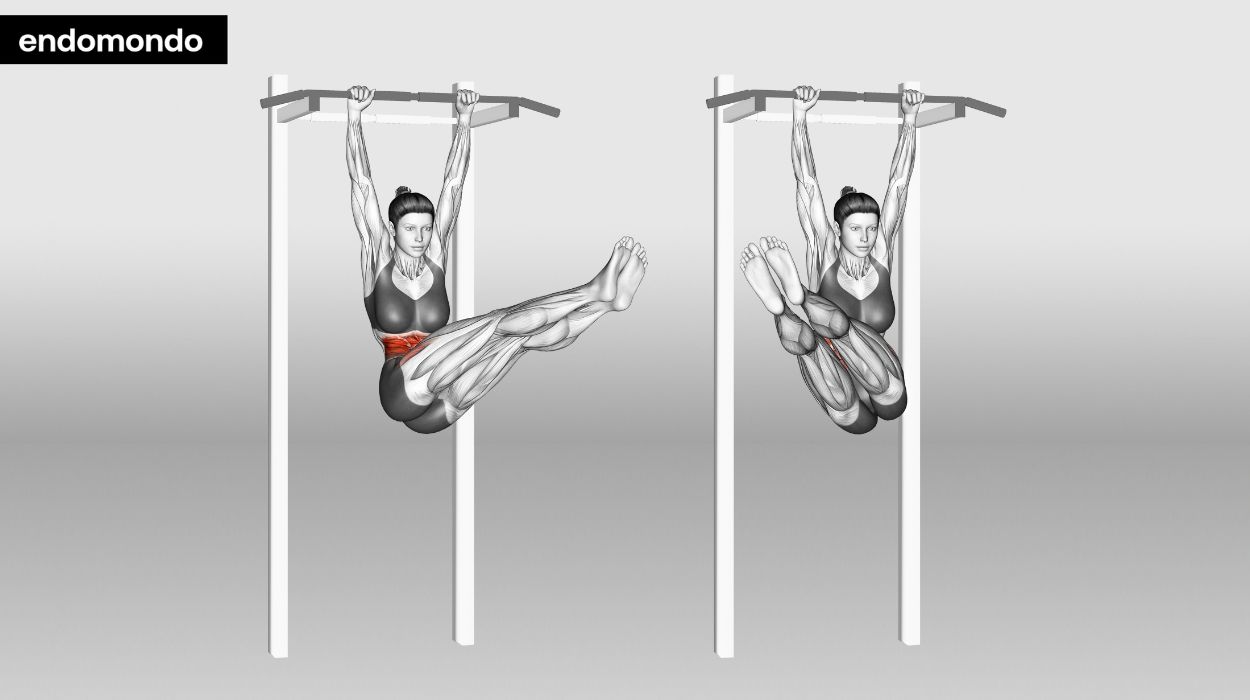
How to do:
- Start with a dead hang from the pull-up bar with an overhand grip, legs straight, and feet touching.
- Initiate the movement by keeping your legs and knees straight and slowly swinging them from side to side.
- Do this in a controlled manner, like a windshield wiper.
- Keep your core tight and focus on maintaining stability throughout the movement.
- Exhale as you rotate your legs side to side, inhale at the center.
Tips:
- Keep your core engaged and your legs straight during the entire movement.
- Control the motion to prevent swinging, focusing on a slow and controlled side-to-side motion.
- Maintain a firm grip on the bar and ensure your upper body remains stable.
Optimal Sets and Reps: Three sets of six to eight repetitions per side.
Advantages Of Doing Pull Up For Abs
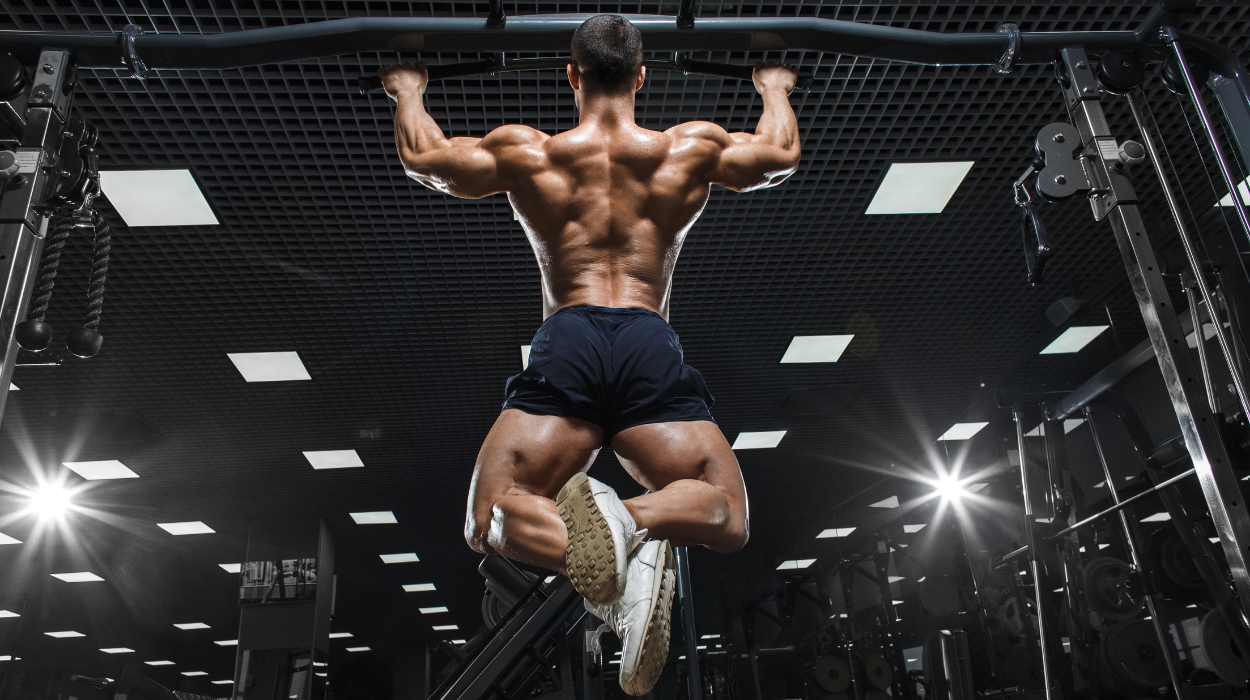
Exercise[1] has numerous benefits to the entire body since it targets and improves almost all body systems. It may help you burn body fat, helping you lose weight. Exercise also enhances heart,[2] skeletal muscle,[3] respiratory health,[4] and more. Paired with a healthy diet, you can achieve so much more.
Narrowing it down to a pull-up abdominal exercise routine, here is what you gain.
Targeted Ab Engagement And Muscle Activation
Pull-up bar ab workouts efficiently engage and activate the abdominal muscles. The motion is a short movement that enhances upper body endurance and strength.[5] Using different variations of pull-up bars for ab exercises allows precise targeting.
You can target the rectus abdominis, obliques, and hip flexors by both dead and active hanging. With progressive overload, you may boost muscle-building and development faster in the targeted muscles.
Progressive overload[6] states that for the body to adapt, it must be exposed to a greater workload than previously. You can achieve this by progressively increasing resistance, intensity, volume, or exercise duration. Do this one rep after the other, and you may see results.
Full-Body Involvement And Functional Strength
Pull-up bar ab workouts engage the entire upper body creating a comprehensive training stimulus.
Ab exercises on a pull-up bar require upper body strength and grip stability. This hanging exercise also engages the fingers,[7] back, shoulders, and arms. The hanging position challenges the muscles and tendons in these regions to stabilize and strengthen the body. This may lead to enhanced overall functional strength of your entire core and upper body.
Versatility And Advanced Variations
Yet another unspoken advantage of pull-up bars is that they offer a wide range of exercise variations. This allows progressive overload and continuous improvement. You can do L-sit hanging twists, windshield wipers, or hanging crunches; the options are diverse.
Advanced variations entail hanging knee raise twists and straight leg raises to provide a greater challenge to the core muscles.
Note: Pull-ups are for everyone. However, if you have any prior injuries or need assistance, please consult a trainer.
Precautions
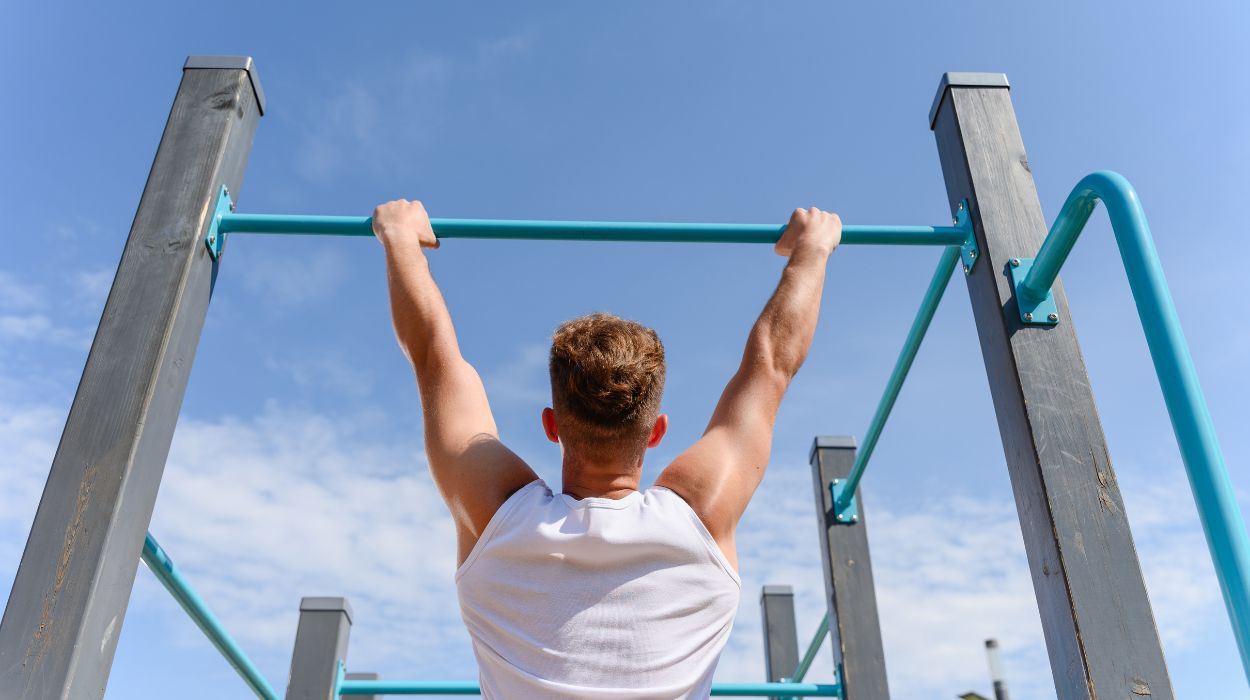
Like any other exercise, pull-up bar exercises for abs also have a few safety concerns. Here are some you should be aware of:
- Always warm up your core exercises with dynamic exercises like arm circles to increase blood flow. Cool down to return to a steady state of resting metabolism.
- Maintain proper form throughout the exercise.
- Begin with a difficulty that matches your fitness level and gradually progress to more challenging variations.
- Develop adequate grip strength to maintain a secure hold on the bar. Strengthen your grip through farmer’s walks, deadlifts, or grip-specific exercises.
- Allow sufficient rest and recovery time between workouts.
- Take care of your joints by performing exercises to strengthen the surrounding muscles.
- Gradually increase your pull-up workouts’ intensity, volume, or difficulty over time.
- Pay attention to any pain or discomfort during or after pull-ups and consult a healthcare professional if needed.
The Bottom Line
Incorporating an ab workout on a pull-up bar routine into your fitness routine is a powerful way to boost core strength. It may also help with weight loss as it sculpts a well-defined midsection.
However, it’s important to remember that achieving optimal results extends beyond just the workout. It is crucial to complement your workout with a healthy lifestyle to maximize the benefits of your pull-up bar ab routine. To train optimally you may need to use certified vitamins and supplements and, of course, a healthy diet. Your diet must be rich in lean proteins, whole grains, fruits, and vegetables to provide the nutrients for muscle development.
Furthermore, maintaining a consistent ab workout on a pull-up bar routine is key. Consistency breeds results and helps you make significant strides toward your fitness goals.
So, combine the power of a pull-up bar ab workout, a nutrient-rich diet, and a consistent exercise regimen. Embrace this holistic approach to fitness, and let your commitment to a healthy lifestyle shine through in every aspect of your journey.
Frequently Asked Questions
Experts recommend giving your abs at least one day of rest between workouts.
Strong abs play a significant role in stabilizing your body during pull-ups.
Yes, hanging exercises like leg raises engage and strengthen the abs.
There is no single exercise; experts recommend a variety of movements for comprehensive ab development.
Resources
- Ruegsegger, G.N. and Booth, F.W. (2017). Health Benefits of Exercise. [online] 8(7), pp.a029694–a029694. doi:https://doi.org/10.1101/cshperspect.a029694.
- Pinckard, K.M., Baskin, K.K. and Stanford, K.I. (2019). Effects of Exercise to Improve Cardiovascular Health. [online] 6. doi:https://doi.org/10.3389/fcvm.2019.00069.
- Distefano, G. and Goodpaster, B.H. (2017). Effects of Exercise and Aging on Skeletal Muscle. [online] 8(3), pp.a029785–a029785. doi:https://doi.org/10.1101/cshperspect.a029785.
- Your lungs and exercise. (2016). [online] 12(1), pp.97–100. doi:https://doi.org/10.1183/20734735.elf121.
- Snarr, R.L., Hallmark, A.V., Casey, J.C. and Esco, M.R. (2017). Electromyographical Comparison of a Traditional, Suspension Device, and Towel Pull-Up. [online] 58(1), pp.5–13. doi:https://doi.org/10.1515/hukin-2017-0068.
- Vlad Adrian Geanta and Ardelean Viorel Petru (2021). Improving muscle size with Weider’s principle of progressive overload in non-performance athletes. [online] ResearchGate. Available at: https://www.researchgate.net/publication/358008997_Improving_muscle_size_with_Weider’s_principle_of_progressive_overload_in_non-performance_athletes
- Laurent Vigouroux, Devise, M., Cartier, T., Aubert, C. and Berton, E. (2018). Performing pull-ups with small climbing holds influences grip and biomechanical arm action. [online] 37(8), pp.886–894. doi:https://doi.org/10.1080/02640414.2018.1532546.




